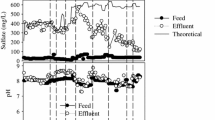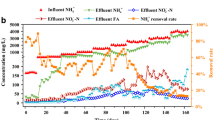Abstract
The effects of different electron donors on sulfate reduction at high COD/SO42− and haloalkaline conditions were investigated. For this purpose, the anaerobic submerged membrane reactor, fed with acetate and ethanol as an electron donor, was operated at a salinity of 10 g NaCl/L and a high pH (about 9.5) for 210 days. The bioreactor was inoculated with a mixed haloalkaliphilic culture and was enriched with saline soda from Lake Van, Turkey. The bioreactor’s performance was mainly evaluated with the removal of chemical oxygen demand (COD) and sulfate and changes in microbial community. A significant increase for both COD and sulfate removal was simultaneously achieved in the ethanol-fed bioreactor. The highest removal efficiency of COD and sulfate was about 70% and 80%, respectively, once the ratio of COD/SO42− was 6. The effect of hydraulic retention time on treatment performance of the bioreactor was inconsiderable as a result of the low flux during the whole operation time. There was no biogas production throughout the experiment due to the haloalkaline condition in reactor medium. From DGGE analysis, it was postulated that ethanol usage can cause bacterial abundance and diversity in bioreactor medium with no detection of sulfate-reducing bacteria.








Similar content being viewed by others
References
Pineau, S.: Formation of the Fe(II–III) hydroxysulphate green rust during marine corrosion of steel associated to molecular detection of dissimilatory sulphite-reductase. Corros. Sci. 50(4), 1099–1111 (2008)
Silva, A.M.; Lima, R.M.F.; Leao, V.A.: Mine water treatment with limestone for sulfate removal. J. Hazard. Mater. 221–222, 45–55 (2012)
Ashane, W.; Fernando, M.; Ilankoon, I.M.S.K.; Syed, T.H.; Yellishetty, M.: Challenges and opportunities in the removal of sulphate ions in contaminated mine water: a review. Miner. Eng. 117, 74–90 (2018)
Brahmacharimayum, B.; Mohanty, M.P.; Ghosh, P.K.: Theoretical and practical aspects of biological sulfate reduction: a review. Glob. Nest J. 21(2), 222–244 (2019)
McCarty, P.L.; Sawyer, C.N.; Parkin, G.F.: Chemistry for Environmental Engineering and Science. Mc-Graw-Hill, New York (2003)
Jing, Z.; Hu, Y.; Niu, Q.; Liu, Y.; Li, Y.; Wang, X.C.: UASB performance and electron competition between methane-producing archea and sulfate-reducing bacteria in treating sulfate-rich wastewater containing ethanol and acetate. Bioresour. Technol. 137, 349–357 (2013)
Kalyuzhnyi, S.V.; Leon-Fragoso, C.D.; Rodriguez-Martinez, J.: Biological sulfate reduction in an UASB reactor fed with an ethanol as electron donor. Microbiology 66, 674–680 (1997)
Acharya, B.K.; Mohana, S.; Madamwar, D.: Anaerobic treatment of distillery spent wash—a study on upflow anaerobic fixed film bioreactor. Bioresour. Technol. 99, 4621–4626 (2008)
Li, Y.Y.; Lam, S.; Fang, H.H.P.: Interactions between methanogenic, sulfate-reducing and syntrophic acetogenic bacteria in the anaerobic degradation of benzoate. Water Res. 30, 1555–1562 (1996)
Zhao, Y.G.; Wang, A.J.; Ren, N.Q.: Effect of carbon sources on sulfidogenic bacterial communities during the starting-up of acidogenic sulfate-reducing bioreactors. Bioresour. Technol. 101, 2952–2959 (2010)
Zhou, J.; Xing, J.: Effect of electron donors on the performance of haloalkaliphilic sulfate-reducing bioreactors for flue gas treatment and microbial degradation patterns related to sulfate reduction of different electron donors. Biochem. Eng. J. 96, 14–22 (2015)
Nagpal, S.; Chuichulcherm, S.; Peeva, L.; Livingston, A.: Microbial sulfate-reduction in a liquid–solid fluidized bed reactor. Biotechnol. Bioeng. 70, 370–380 (2000)
Vallero, M.V.G.; Lettinga, G.; Lens, P.N.L.: High sulfate reduction in a submerged anaerobic membrane bioreactor (SAMBaR) at high salinity. J. Membr. Sci. 253, 217–232 (2005)
Zhao, Y.G.; Li, X.W.; Wang, J.C.; Bai, J.; Tian, W.J.: Performance of a sulfidogenic bioreactor and bacterial community shifts under alkalinity levels. Bioresour. Technol. 101, 9190–9196 (2010)
Sahinkaya, E.; Yurtsever, A.; Isler, E.; Coban, I.; Aktaş, Ö.: Sulfate reduction and filtration performance of an anaerobic membrane bioreactor (AnMBR). Chem. Eng. J. 349, 47–55 (2018)
De Smul, A.; Dries, J.; Goethals, L.; Verstraete, W.: High rates of microbial sulphate reduction in a mesophilic ethanol-fed expanded-granular-sludge-blanket reactor. Appl. Microbiol. Biotechnol. 48, 297–303 (1997)
Sousa, J.A.; Plugge, C.M.; Stams, A.J.; Bijmans, M.F.: Sulfate reduction in a hydrogen fed bioreactor operated at haloalkaline conditions. Water Res. 68, 67–76 (2015)
Sorokin, I.D.; Kravchenko, I.K.; Doroshenko, E.V.; Boulygina, E.S.; Zadorina, E.V.; Tourova, T.P.; Sorokin, D.Y.: Haloalkaliphilic diazotrophs in soda solonchak soils. FEMS Microbiol. Ecol. 65, 433–452 (2008)
Sorokin, D.Y.; Tourova, T.P.; Kolganova, T.V.; Detkova, E.N.; Galinski, E.A.; Muyzer, G.: Culturable diversity of lithotrophic haloalkaliphilic sulfate-reducing bacteria in soda lakes and the description of Desulfonatronum thioautotrophicum sp. nov. Desulfonatronum thiosulfatophilum sp. nov. Desulfonatronovibrio. Extremophiles 15, 391–401 (2011)
Zhao, B.; Yan, Y.; Chen, S.: How could haloalkaliphilic microorganisms contribute to biotechnology? Can. J. Microbiol. 60, 717–727 (2014)
Liamleam, W.; Annachhatre, A.P.: Electron donors for biological sulfate reduction. Biotechnol. Adv. 255, 452–463 (2007)
Zhou, J.M.; Song, Z.Y.; Yan, D.J.; Liu, Y.L.; Yang, M.H.; Cao, H.B.; Xing, J.M.: Performance of a haloalkaliphilic bioreactor and bacterial community shifts under different COD/SO −24 ratios and hydraulic retention times. J. Hazard. Mater. 275, 53–62 (2014)
Zhou, J.M.; Song, Z.Y.; Yan, D.J.; Liu, Y.L.; Yang, M.H.; Cao, H.B.; Xing, J.M.: Performance of a haloalkaliphilic bioreactor under different NO3−/SO42−. Bioresour. Technol. 153, 216–222 (2014)
Kempe, S.; Kazmierczak, J.; Landmann, G.; Konuk, T.; Reimer, A.; Lipp, A.: Largest known microbialites discovered in Lake Van, Turkey. Nature 349, 605–608 (1991)
https://www.dsmz.de/microorganisms/medium/pdf/DSMZ_Medium742.pdf. Accessed 04 April 2018
Aslan, M.; Saatçi, Y.; Hanay, O.; Hasar, H.: Effect of biogas sparging with different membrane modules on membrane fouling in anaerobic submerged membrane bioreactor (AnSMBR). Environ. Sci. Pollut. Res. 21(5), 3285–3293 (2014)
APHA: Standard Methods for the Examination of Water and Wastewater, 18th edn. APHA, Washington, D.C. (1992)
Taskan, E.; Hasar, H.: Comprehensive comparison of a new tin-coated copper mesh and a graphite plate electrode as an anode material in microbial fuel cell. Appl. Biochem. Biotechnol. 175, 2300–2308 (2015)
Kolmert, A.; Johnson, D.B.: Remediation of acidic waste waters using immobilised, acidophilic sulfate-reducing bacteria. J. Chem. Technol. Biotechnol. 76, 836–843 (2001)
Koschorreck, M.; Kunze, T.; Luther, G.; Bozau, E.; Wendth-Potthoff, K.: Accumulation and inhibitory effects of acetate in a sulphate reducing in situ reactor for the treatment of an acidic pit lake. In: Mine Water Process, Policy and Progress, IMWA Symposium, Newcastle upon Tyne/UK, 19–23 September, International Mine Water Association (IMWA), pp. 101–109 (2004)
Lens, P.N.L.; Visser, A.; Jannsen, A.J.H.; Hulshoff, P.L.W.; Lettinga, G.: Biotechnological treatment of sulfate rich wastewaters. Crit. Rev. Environ. Sci. Technol. 28, 41–88 (1998)
Stephenson, T.; Judd, S.; Jefferson, B.; Brindle, K.: Membrane Bioreactor for Wastewater Treatment. IWA Publishing, London (2000)
Hao, T.; Xiang, P.; Mackey, H.R.; Chi, K.; Lu, H.; Chui, H.K.; Loosdrecht, M.C.M.V.; Chen, G.H.: A review of biological sulfate conversions in wastewater treatment. Water Res. 65, 1–21 (2014)
Yurtsever, A.; Çınar, Ö.; Sahinkaya, E.: Treatment of textile wastewater using sequential sulfate-reducing anaerobic and sulfide-oxidizing aerobic membrane bioreactors. J. Membr. Sci. 511, 228–237 (2016)
Liu, B.; Wu, W.F.; Zhao, Y.J.; Gu, X.Y.; Li, S.; Zhang, X.X.; Wang, Q.; Li, R.L.; Yang, S.G.: Effects of ethanol/SO42− ratio and pH on mesophilic sulfate reduction in UASB reactors. Afr. J. Microbiol. Res. 4, 2215–2222 (2010)
Rzeczycka, M.; Miernik, A.; Markiewicz, Z.: Simultaneous degradation of waste phosphogypsum and liquid manure from industrial pig farm by a mixed community of sulfate reducing bacteria. Pol. J. Microbiol. 59, 241–247 (2010)
Akuzawa, M.; Hori, T.; Haruta, S.; Ueno, Y.; Ishii, M.; Igarashi, Y.: Distinctive responses of metabolically active microbiota to acidification in a thermophilic anaerobic digester. Microb. Ecol. 61, 595–605 (2011)
Zhu, L.; Dai, X.; Xu, X.; Lv, M.; Cao, D.: Microbial community analysis for aerobic granular sludge reactor treating high-level 4-chloroaniline wastewater. Int. J. Environ. Sci. Technol. 11, 1845–1854 (2014)
Jin, Z.; Ji, F.Y.; Xu, X.; Xu, X.Y.; Chen, Q.K.; Li, Q.: Microbial and metabolic characterization of a denitrifying phosphorus-uptake/side stream phosphorus removal system for treating domestic sewage. Biodegradation 25, 777–786 (2014)
Zeng, T.J.; Yang, G.J.; Wang, D.B.; Li, X.M.; Zheng, W.; Yang, Q.; Zeng, G.M.: Microbial community analysis involved in the aerobic/extended-idle process performing biological phosphorus removal. Water Sci. Technol. 67, 485–493 (2013)
van Houten, B.H.; van Doesburg, W.; Dijkman, H.; Copini, C.; Smidt, H.; Stams, A.J.: Long-term performance and microbial community analysis of a full-scale synthesis gas fed reactor treating sulfate-and zinc-rich wastewater. Appl. Microbiol. Biotechnol. 84, 555–563 (2009)
Camejo, P.Y.; Santo Domingo, J.; McMahon, K.D.; Noguera, D.R.: Genome-enabled insights into the ecophysiology of the comammox bacterium “Candidatus Nitrospira nitrosa”. Appl. Environ. Sci. 2(5), 00059-17 (2017)
Dafale, N.; Agrawal, L.; Kapley, A.; Meshram, S.; Purohit, H.; Wate, S.: Selection of indicator bacteria based on screening of 16S rDNA metagenomic library from a two-stage anoxic–oxic bioreactor system degrading azo dyes. Bioresour. Technol. 101, 476–484 (2010)
Kilic, A.; Sahinkaya, E.; Cinar, O.: Kinetics of autotrophic denitrification process and the impact of sulphur/limestone ratio on the process performance. Environ. Technol. 35, 2796–2804 (2014)
Abdel-Rahman, M.A.; Desouky, S.E.S.; Azab, M.S.; Esmael, M.E.: Fermentative production of polyhydroxyalkanoates (PHAs) from glycerol by Zobellella taiwanensis Azu-IN1. J. Appl. Biol. Biotechnol. 5, 16–25 (2017)
Wang, K.; Sheng, Y.; Cao, H.; Yan, K.; Zhang, Y.: Impact of applied current on sulfate-rich wastewater treatment and microbial biodiversity in the cathode chamber of microbial electrolysis cell (MEC) reactor. Chem. Eng. J. 307, 150–158 (2017)
Hao, T.; Wei, L.; Lu, H.; Chui, H.; Mackey, H.R.; van Loosdrecht, M.C.; Chen, G.: Characterization of sulfate-reducing granular sludge in the SANI® process. Water Res. 47, 7042–7052 (2013)
Garcia, G.P.P.; Diniz, R.C.O.; Bicalho, S.K.; Franco, V.A.D.S.; Gontijo, E.M.D.O.; Toscano, R.A.; Canhestro, K.O.; Santos, M.R.D.; Carmo, A.L.R.D.; Lobato, L.C.S.; Brandt, E.M.F.; Chernicharo, C.A.L.; Araujo, J.C.D.: Biological sulphide removal from anaerobically treated domestic sewage: reactor performance and microbial community dynamics. Environ. Technol. 36, 2177–2189 (2015)
Wilcox, S.J.; Hawkes, D.L.; Hawkes, F.R.; Guwy, A.J.: A neural network, based on bicarbonate monitoring, to control anaerobic digestion. Water Res. 29, 1465–1470 (1995)
Pendatesh, A.R.; Razi, F.; Madaeni, S.; Abdullah, L.; Abidin, Z.; Biak, D.R.: Membrane foulants characterization in a membrane bioreactor (MBR) treating hypersaline oily wastewater. Chem. Eng. J. 168, 140–150 (2011)
Acknowledgements
The significant part of this work includes PhD Thesis data of Hande Türk. This research was financially supported by The Scientific and Technological Research Council of Turkey (TUBITAK) with project numbers 116Y133 and 110Y093. We also thank Burcin Yildiz and Ergin Taskan for their technical assistance.
Author information
Authors and Affiliations
Corresponding author
Electronic supplementary material
Below is the link to the electronic supplementary material.
Rights and permissions
About this article
Cite this article
Hanay, Ö., Turk, H. The Evaluation of Simultaneous COD and Sulfate Removal at High COD/SO42− Ratio and Haloalkaline Condition. Arab J Sci Eng 45, 4463–4475 (2020). https://doi.org/10.1007/s13369-020-04451-4
Received:
Accepted:
Published:
Issue Date:
DOI: https://doi.org/10.1007/s13369-020-04451-4




